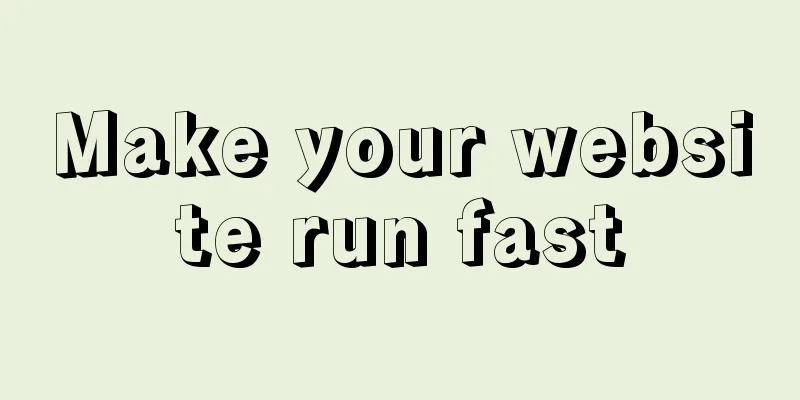Make your website run fast

|
Does performance really matter? HTML 1. Avoid inline/embedded code: <html>
<head>
<meta charset="UTF-8">
<title>Browser Diet</title>
<!-- CSS -->
<link rel="stylesheet" href="style.css" media="all">
</head>
<body>
<a>hello</a>
<!-- JS -->
<script async src="script.js"></script>
</body>
</html> 1) The style is in the head, and the page renders quickly, which makes the user feel that the page loads quickly. On the contrary, you will first see a messy page layout, which gives people a bad feeling.
When writing tag attributes, it is best to keep multiple identical tag attribute values in the same order. Can make gzip compression faster. CSS .img {
background-image: url('image.png');
}After use: .img {
background-image: url('data:image/png;base64,iVBORw0KGgo');} Base64 image encoding is only for individual images, not CSS sprite images, and supports mainstream browsers and IE8 and above. The number of http requests can be reduced, but for HTML and CSS without gzip compression, it is not advisable to reduce the large files obtained by http requests.
In summary, continuous jpg format is better for performance. var vst = document.createElement('script');
vst.type = 'text/javascript';
vst.async = true;
vst.src = srcIndex;
var s = document.getElementsByTagName('script')[0];
s.parentNode.insertBefore(vst, s); When some third-party files become a problem to download or cause heavy page loading. We need to load these files asynchronously, async is a good way. var str = "nanananana";
for (var n = 0; n < str.length; n++) {}After use: var str = "nanananana",
strLgth = str.length;
for (var n = 0; n < strLgth ; n++) {} Loops consume a lot of performance. Storing the looped objects can reduce the need to perform object calculations in each loop. var coored = document.getElementById("ctgHotelTab");
document.getElementById("ctgHotelTab").style.top = coored.offsetTop + 35 + "px";After use: var coored = document.getElementById("ctgHotelTab"),
offsetTop = coored.offsetTop + 35;
document.getElementById("ctgHotelTab").style.top = offetTop + "px"; When the layout of an element remains unchanged but the appearance changes, it causes a repaint. |
<<: vmware virtual machine ubuntu18.04 installation tutorial
>>: Implementation of CSS Fantastic Border Animation Effect
Recommend
How to install Docker on Raspberry Pi
Because the Raspberry Pi is based on ARM architec...
Payment function implementation in vue project (WeChat payment and Alipay payment)
Table of contents Common payment methods in proje...
Vue implements verification code countdown button
This article example shares the specific code of ...
An example of changing traditional replication to GTID replication without stopping business in MySQL 5.7
Due to the advantages of GTID, we need to change ...
Install Docker on CentOS 7
If you don't have a Linux system, please refe...
A brief discussion on the VUE uni-app life cycle
Table of contents 1. Application Lifecycle 2. Pag...
Tomcat server security settings method
Tomcat is an HTTP server that is the official ref...
Solve the problem of running jupyter notebook on the server
Table of contents The server runs jupyter noteboo...
Summary of some practical little magic in Vue practice
How can you forget lazy loading of routes that al...
Difference and principle analysis of Nginx forward and reverse proxy
1. The difference between forward proxy and rever...
How to modify the length limit of group_concat in Mysql
In MySQL, there is a function called "group_...
Detailed explanation of JavaScript program loop structure
Table of contents Select Structure Loop Structure...
How to batch generate MySQL non-duplicate mobile phone number table example code
Preface In many MySQL test scenarios, some test d...
HTML version declaration DOCTYPE tag
When we open the source code of a regular website...
Detailed explanation of the use of Docker commit
Sometimes you need to install certain dependencie...











